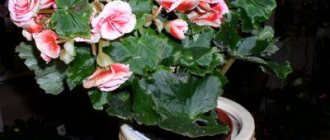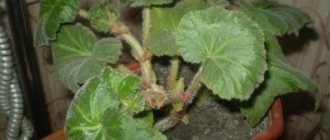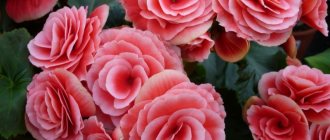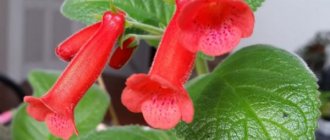Growing indoor begonia
Flower growers always place special hopes on begonia. They expect extravaganzas of flowering, well-developed bushes, and beautiful decorative leaves. For this reason, tubers are carefully stored until spring, seedlings are grown, and they are carefully looked after.
If you have not yet decided on a variety, then our article “Types and popular varieties of begonia” will help you choose the right one.
Brief description of the plant
Begonia can be different; there are varieties of herbaceous plants that do not exceed three centimeters, as well as shrubs with rather high branches.
Some begonia species have no stem or only one leaf. The foliage of the plant is green, the reverse side is covered with a single color or with spots and patterns.
It blooms with bright flowers in different warm shades. The flowers resemble rose petals or carnations in appearance. Flowering occurs at the beginning of summer and continues until autumn. Indoor begonia blooms longer than plants growing outside. The home flowerpot blooms from May to late autumn.
Begonia varieties
According to their decorative properties, all types of begonias are divided into deciduous and flowering. Deciduous varieties are valued because they have beautiful colors and interesting foliage shapes. They bloom with small flowers, which are most often torn off.
Flowering begonias have petals of different shades, shapes and sizes.
According to the structure of the rhizomes, begonias are:
- tuberous, which shed their upper part in the winter and hibernate;
- rhizomatous, which form a good powerful root system. The shoots do not die off during the winter, but the plant needs rest;
- plants whose root system grows superficially. In ever-flowering flowerpots, rhizomes develop quickly.
At home, flower growers grow royal, ampelous or elatior.
Royal begonias have large, patchy dark green, brown or red leaves. An ornamental deciduous plant can have leaves in the shape of a heart or a snail's spiral.
In ampelous begonia, the shoots hang down and bloom with white, yellow and other shades of flowers. Flowering occurs throughout the entire growth period.
Begonia elatior is grown only at home. It has thin red shoots that must be tied to a support. This variety blooms in autumn and blooms during the winter. Blooms in white, yellow, red, orange shades. The plant has glossy rounded leaves, 5 centimeters in diameter.
What to do next with the plant?
What to do with the plant depends on the type of root system (you can learn about the types of begonia and its root systems here).
Tuberous
If the begonia is tuberous, the roots are dug up to save them until next year. Rules:
- When the above-ground part is dry, the tubers are pulled out of the pot.
- Remove all dried roots.
- Inspect for rotting. If there are rotten roots, they are carefully trimmed with a sharp knife. Sprinkle with charcoal powder and dry.
For storage, the tubers are placed in an airtight container, lightly sprinkled with sawdust or damp sand. Planting material is kept in a cold place until spring.
Watch a video about what to do with tuberous begonia during the dormant period:
Not tuberous
In begonias with a regular root system, the flowering period lasts until spring. It is recommended to give plants rest.
Note! As soon as flowering begins to decline, the conditions for keeping the crop are changed from November-December.
To do this, take the following actions:
- Stop feeding.
- Reduce watering. The soil is moistened when it becomes completely dry.
- Trim the plant. Unnecessary shoots are removed, the main ones are trimmed, leaving 12-15 cm. The cut areas are treated with coal powder.
Begonias need to be provided with a normal level of humidity. You can spray the air around the plant or install a tray with water. Pebbles are poured into the bottom of the container and a pot is placed on top.
The flower is taken to a dark place. Bright light promotes resumption of flowering, and buds are formed during short daylight hours. The temperature during this period is reduced to + 10-15 degrees.
From the video you will learn what to do if the non-tuberous begonia has faded:
Features of plant care
In order for begonia to bloom profusely and for a long time, it is important to create the right growing conditions. With timely watering and feeding, a plant at home can delight the eye with flowering almost throughout the year. In addition, it needs protection from pests. If you neglect the rules of caring for a flower, it may suffer from rot or another dangerous disease.
Lighting Features
Blooming begonia loves bright light. Therefore, it must be grown on windowsills with good lighting. In summer, it is recommended to shade the plant from direct sunlight. Since the sun can burn the beautiful leaves and flowers of the flowerpot.
Decorative deciduous begonia varieties grow and bloom best in diffused light. Therefore, they are grown on windowsills on the east or west side.
Pests and diseases
If errors are made in crop care, the following pathologies can be observed: ring spot, bacterial spot, powdery mildew and other diseases.
Signs of powdery mildew are: whitish coating on the foliage and stem, curled leaves, deformation, drying or non-blooming inflorescences. As preventive measures, constant ventilation of the room and regular fertilizers are necessary.
The most dangerous of them is considered gray (root) rot. It is usually preceded by abundant watering, high humidity, and lack of drainage. In this case, the root system is affected. Visually this manifests itself in the appearance of mold. To get rid of this disease, it is necessary to remove the affected parts at the initial stage.
The plant can be affected by mealybugs, which are located in the leaf axils and look like rough bundles. This insect creates a fluffy web. Because of this, it is also called the hairy aphid. The reason for its appearance is the accumulation of dirt and dust on the flower.
Flower propagation methods
Begonia is propagated using leaf cuttings, stems, and dividing bushes. But in order for the plant to take root and bloom successfully in the allotted time, it is important to take into account its type and variety. Since some flowers are propagated only by dividing the bush, and some only by cuttings from leaves. To propagate a tuberous begonia variety, you need to purchase seeds or have tubers.
Propagation by cuttings
In spring or summer, begonia can be propagated using the cutting procedure:
- From a healthy plant, cut a cutting 7 centimeters long.
- Plant the cut stem in sand mixed with peat in a 3:1 ratio.
- Place the container with the planting in a dark place.
- After a couple of months, the plant will take root and begin to grow successfully.
To propagate begonia from leaf cuttings, choose a healthy, vigorous plant. Dig the cutting into the soil so that the leaf does not touch the top layer of soil. Until the leaf takes root, it is recommended to keep the container with it in a dark room.
Propagation by seeds
Begonia propagates by seeds from December to early March. The seeds are sown in an even layer in leaf soil mixed with peat and sand. When sowing, each seed should be lightly pressed into the soil. In two weeks the first shoots will begin to appear.
It is important to distribute the seedlings into different containers. After some time, young, strong plants are transplanted into separate pots with properly selected soil. If begonias are healthy and growing successfully, you can see them blooming already in mid-summer. Before winter, the plant tuber will be fully formed. In autumn, the tubers are buried in sand or peat for winter storage. Store at a temperature no higher than 10 degrees Celsius. In spring, the tubers are replanted in pots with updated soil.
Propagation by tubers
The procedure for propagating begonias by tubers:
- In the fall, carefully remove the tubers from the soil.
- Trim the foliage.
- Clean the roots well from the soil.
- Carefully separate the tuber into pieces.
- Place the finished tuber particles in peat so that they do not dry out.
- After some time, transplant the tubers into pots with sandy soil and water them moderately.
It will take a long time for a tuberous begonia to germinate. The beginning of the germination process will be indicated by the emerging shoots and roots.
How to propagate begonia at home
Begonia is propagated by seeds, cuttings or division of the tuber.
Seed propagation is a very troublesome task, so it is rarely resorted to. For example, if the variety you like is difficult to get in your area.
Begonia cuttings are the best propagation option. In spring, begonia shoots are cut into cuttings and rooted in a moist substrate. To speed up the process, a greenhouse is built over the cuttings. This will help maintain the required humidity, but remember that the greenhouse needs to be ventilated. Rooting can be considered successful if leaves appear on the apical shoots. Once the cuttings are strong, they are transplanted into a permanent growing pot.
Only an adult plant, which is more than 2 years old, reproduces by dividing the tubers. In the spring, before planting the plant, its tuber is divided into several parts, so that each has developed buds. The cut area must be sprinkled with crushed charcoal to prevent rot from forming. Next, care for the begonia as usual.
Problems during cultivation
It often happens that begonia does not want to bloom. This problem occurs when:
- insufficient lighting;
- improperly selected soil;
- improper transplantation;
- not timely fertilization;
- absence of a rest period;
- too dry air;
- pest damage;
- severe drying of the soil or watering with hard water.
In order for begonia to start blooming again, it is necessary to change the growing conditions.
Sometimes a begonia cannot bloom due to age or an incorrectly planted plant. If the shrub does not bloom, it may be a variety with decorative leaves. Decorative deciduous begonias have beautiful leaves of large or small sizes, with an exquisite shape and pattern. Often the stems of such plants are creeping, and the foliage rises high on elongated cuttings. Decorative deciduous begonias do not bloom, but there are varieties of this species that bloom very few small flowers.
How to propagate begonia at home
Begonia is propagated by seeds, cuttings or division of the tuber.
Seed propagation is a very troublesome task, so it is rarely resorted to. For example, if the variety you like is difficult to get in your area.
Begonia cuttings are the best propagation option. In spring, begonia shoots are cut into cuttings and rooted in a moist substrate. To speed up the process, a greenhouse is built over the cuttings. This will help maintain the required humidity, but remember that the greenhouse needs to be ventilated. Rooting can be considered successful if leaves appear on the apical shoots. Once the cuttings are strong, they are transplanted into a permanent growing pot.
Only an adult plant, which is more than 2 years old, reproduces by dividing the tubers. In the spring, before planting the plant, its tuber is divided into several parts, so that each has developed buds. The cut area must be sprinkled with crushed charcoal to prevent rot from forming. Next, care for the begonia as usual.
Features of growing begonia in open ground
If you decide to grow begonia in a flowerbed, be sure to keep in mind that it does not tolerate frost. Therefore, it is recommended to plant in open ground or take pots out into the fresh air in April or May. It is recommended to grow the flower in a flower bed well lit by the sun. But you should protect it from drought. If the plant is planted in shade or partial shade, it will develop slowly and not bloom very profusely.
Begonia grown in open ground blooms from June to September. If you have time to transplant the plant into a pot before the onset of frost and bring it into a warm room, it will continue to bloom for another two to three months. You need to water the outdoor flower when the top layer of soil becomes dry.
To decorate flower beds and borders, flower growers plant Illumination, Nonstop, Chanson. The Illumination variety is planted in balcony boxes and flowerpots, as it has weeping stems. The Nonstop variety has erect stems reaching a height of 20 centimeters. It blooms with large yellow flowers. The hanging variety Chanson has beautiful cascading double flowers reaching 6 centimeters in diameter.
Now you know when begonia blooms, how it is grown, and also how long it can bloom. In order for the plant to bloom abundantly and for a long time, it is important to provide it with all comfortable conditions. Replant, water, feed in a timely manner. Propagate if necessary. Begonia should also be protected from pests and diseases. Since they can lead to the fact that the flower stops blooming and may even die.
PLUM2GBegonia has faded, what to do next?
Pruning begonias is a way to grow a healthy and beautiful plant. In this article you will learn how, when and with what to prune begonia and what to do after the procedure.
Begonia has bloomed: what to do with it next?
The main thing we expect from flowering plants is the beauty of their flowering. But sooner or later this period ends, the buds wither, and only greenery remains.
Does active care for indoor flowers end here? What can be done at this moment so that the plant blooms again next year?
In this article we will analyze in detail the end of flowering, and learn how to properly care for it at this time. We will also look at the difference between tuberous begonia and those with ordinary roots.
Source: https://sp-smena.ru/dacha/voprosy/begoniya-ottsvela-chto-delat-dalshe.html











